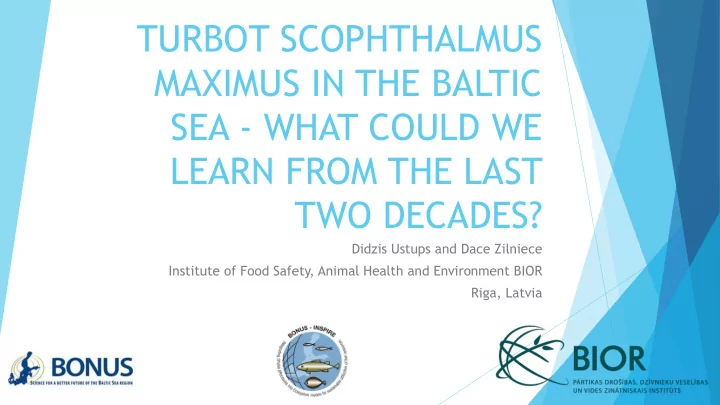

TURBOT SCOPHTHALMUS MAXIMUS IN THE BALTIC SEA - WHAT COULD WE LEARN FROM THE LAST TWO DECADES? Didzis Ustups and Dace Zilniece Institute of Food Safety, Animal Health and Environment BIOR Riga, Latvia
Flatfish in the Baltic Sea flounder Few species plaice Mainly by-catch dab High variations of discards turbot For most of the stocks- no analitical assessment brill
Turbot in the Baltic Sea A shallow water, fast- growing, coastal flatfish Lives in various habitats at depths up to 70 metres Spawning occurs from April to August in shallow waters. Nurseries are located on sandy beaches Turbot is a predator High market price
Stock structure Stock structures was analysed in ICES/HELCOM workshops WKFLABA in 2010 and 2012 Genetic information did not show any stock structure while tagging data indicated the existence of small local stocks. Three tagging studies: migration range - 30 km Further investigations, especially in the Eastern part of Baltic Sea were recommended. Florin, 2006
Management of turbot in the Baltic Sea No TAC Category 3 stock Assessment is survey based – BITS surveys in 1st and 4th quarters Low abundance in surveys Far away from spawning time Fishing ban in spawning time: June-July National fishing regulation in some countries Main fishing in the south part of the Baltic Sea
ICES Advice Gradual decrease of landings Low abundance in stock size indicator ICES, 2017
Length distribution in BITS surveys, 2014-2016 Stock annex, tur23-32 ICES WGBFAS, 2017 Almost no turbot above 35 cm are caught.
Landings of turbot in the Baltic Sea 1200 1000 800 600 400 200 0 22 23 24 25 26 27 28 30-32
Latvian turbot survey Time 1995-2017 Area – ICES SD 26-28 (northern border of distribution area) Sampling time- June-July Sampling intensity – 10 days each month Sampling gear – gillnets 240 mm
Spawning stock index National managenment actions 1) 1995-1999 – start of fishery, high effort 2) 2000-2004- decrease of fishing effort 3) 2005 – small scall fishery only
Length of turbot Signifficant decrease of mean 255 turbot bigger than 50 cm lenght of turbot Only 4 in last 10 years
Latvian index and landings
Seals and flatfish Hansson et al., 2017
Invasive round goby 900 800 Commercial landings, t 700 600 500 400 300 Adundance of flatfish juveniles 200 100 0 2006 2007 2008 2009 2010 2011 2012 2013 2014 2015 2016 2017 Year Ustups et al, 2016
Conclusions Gradual increase of spawning stock is observed in last years The biggest turbots disappeared from the spawning stock New threats or challenges for turbot in the Central Baltic sea – seals and round goby
Thank you!
Recommend
More recommend